+ Open data
Open data
- Basic information
Basic information
| Entry | Database: PDB / ID: 1kzq | ||||||
|---|---|---|---|---|---|---|---|
| Title | crystal structure of a parasite protein | ||||||
 Components Components | Major Surface Antigen P30 | ||||||
 Keywords Keywords | IMMUNE SYSTEM / SAG1 / major surface antigen / Toxoplasma Gondii / parasite invasion / MAD | ||||||
| Function / homology |  Function and homology information Function and homology information | ||||||
| Biological species |  | ||||||
| Method |  X-RAY DIFFRACTION / X-RAY DIFFRACTION /  SYNCHROTRON / SYNCHROTRON /  MAD / Resolution: 1.7 Å MAD / Resolution: 1.7 Å | ||||||
 Authors Authors | He, X. / Grigg, M.E. / Boothroyd, J.C. / Garcia, K.C. | ||||||
 Citation Citation |  Journal: Nat.Struct.Biol. / Year: 2002 Journal: Nat.Struct.Biol. / Year: 2002Title: Structure of the immunodominant surface antigen from the Toxoplasma gondii SRS superfamily. Authors: He, X.L. / Grigg, M.E. / Boothroyd, J.C. / Garcia, K.C. | ||||||
| History |
| ||||||
| Remark 300 | BIOMOLECULE: 1 THIS ENTRY CONTAINS THE CRYSTALLOGRAPHIC ASYMMETRIC UNIT WHICH CONSISTS OF 2 CHAIN(S) ...BIOMOLECULE: 1 THIS ENTRY CONTAINS THE CRYSTALLOGRAPHIC ASYMMETRIC UNIT WHICH CONSISTS OF 2 CHAIN(S). SEE REMARK 350 FOR INFORMATION ON GENERATING THE BIOLOGICAL MOLECULE(S). THE AUTHORS HAVE FUNCTIONAL DATA SHOWING THE DIMER IS ACTIVE, AND BIOCHEMICAL DATA SHOWING A MIXTURE OF DIMER AND MONOMER IN SOLUTION. |
- Structure visualization
Structure visualization
| Structure viewer | Molecule:  Molmil Molmil Jmol/JSmol Jmol/JSmol |
|---|
- Downloads & links
Downloads & links
- Download
Download
| PDBx/mmCIF format |  1kzq.cif.gz 1kzq.cif.gz | 119.6 KB | Display |  PDBx/mmCIF format PDBx/mmCIF format |
|---|---|---|---|---|
| PDB format |  pdb1kzq.ent.gz pdb1kzq.ent.gz | 91.7 KB | Display |  PDB format PDB format |
| PDBx/mmJSON format |  1kzq.json.gz 1kzq.json.gz | Tree view |  PDBx/mmJSON format PDBx/mmJSON format | |
| Others |  Other downloads Other downloads |
-Validation report
| Summary document |  1kzq_validation.pdf.gz 1kzq_validation.pdf.gz | 436.7 KB | Display |  wwPDB validaton report wwPDB validaton report |
|---|---|---|---|---|
| Full document |  1kzq_full_validation.pdf.gz 1kzq_full_validation.pdf.gz | 445.3 KB | Display | |
| Data in XML |  1kzq_validation.xml.gz 1kzq_validation.xml.gz | 27.4 KB | Display | |
| Data in CIF |  1kzq_validation.cif.gz 1kzq_validation.cif.gz | 42.1 KB | Display | |
| Arichive directory |  https://data.pdbj.org/pub/pdb/validation_reports/kz/1kzq https://data.pdbj.org/pub/pdb/validation_reports/kz/1kzq ftp://data.pdbj.org/pub/pdb/validation_reports/kz/1kzq ftp://data.pdbj.org/pub/pdb/validation_reports/kz/1kzq | HTTPS FTP |
-Related structure data
| Similar structure data |
|---|
- Links
Links
- Assembly
Assembly
| Deposited unit | 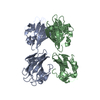
| ||||||||
|---|---|---|---|---|---|---|---|---|---|
| 1 |
| ||||||||
| Unit cell |
|
- Components
Components
| #1: Protein | Mass: 29829.877 Da / Num. of mol.: 2 Source method: isolated from a genetically manipulated source Source: (gene. exp.)   Trichoplusia ni (cabbage looper) / References: UniProt: P13664 Trichoplusia ni (cabbage looper) / References: UniProt: P13664#2: Water | ChemComp-HOH / | Has protein modification | Y | |
|---|
-Experimental details
-Experiment
| Experiment | Method:  X-RAY DIFFRACTION / Number of used crystals: 1 X-RAY DIFFRACTION / Number of used crystals: 1 |
|---|
- Sample preparation
Sample preparation
| Crystal | Density Matthews: 2.73 Å3/Da / Density % sol: 54.87 % | ||||||||||||||||||||||||
|---|---|---|---|---|---|---|---|---|---|---|---|---|---|---|---|---|---|---|---|---|---|---|---|---|---|
| Crystal grow | Temperature: 293 K / Method: vapor diffusion, sitting drop / pH: 5 Details: Ammonium Sulfide, sodium acetate, pH 5.0, VAPOR DIFFUSION, SITTING DROP, temperature 293K | ||||||||||||||||||||||||
| Crystal grow | *PLUS | ||||||||||||||||||||||||
| Components of the solutions | *PLUS
|
-Data collection
| Diffraction |
| |||||||||||||||
|---|---|---|---|---|---|---|---|---|---|---|---|---|---|---|---|---|
| Diffraction source |
| |||||||||||||||
| Detector |
| |||||||||||||||
| Radiation |
| |||||||||||||||
| Radiation wavelength |
| |||||||||||||||
| Reflection | Resolution: 1.7→50 Å / Num. all: 72621 / Num. obs: 72621 / % possible obs: 99.6 % / Observed criterion σ(F): 0 / Observed criterion σ(I): 0 / Redundancy: 10.6 % / Rmerge(I) obs: 0.062 / Net I/σ(I): 7.5 | |||||||||||||||
| Reflection shell | Resolution: 1.7→1.8 Å / Redundancy: 10 % / Rmerge(I) obs: 0.424 / Mean I/σ(I) obs: 1.9 / % possible all: 99.4 | |||||||||||||||
| Reflection | *PLUS Lowest resolution: 50 Å / Num. obs: 138104 | |||||||||||||||
| Reflection shell | *PLUS % possible obs: 99.4 % |
- Processing
Processing
| Software |
| |||||||||||||||||||||||||
|---|---|---|---|---|---|---|---|---|---|---|---|---|---|---|---|---|---|---|---|---|---|---|---|---|---|---|
| Refinement | Method to determine structure:  MAD / Resolution: 1.7→50 Å / Isotropic thermal model: Isotropic / Cross valid method: THROUGHOUT / σ(F): 0 / σ(I): 0 / Stereochemistry target values: Engh & Huber MAD / Resolution: 1.7→50 Å / Isotropic thermal model: Isotropic / Cross valid method: THROUGHOUT / σ(F): 0 / σ(I): 0 / Stereochemistry target values: Engh & Huber
| |||||||||||||||||||||||||
| Displacement parameters | Biso mean: 31.1 Å2
| |||||||||||||||||||||||||
| Refine analyze |
| |||||||||||||||||||||||||
| Refinement step | Cycle: LAST / Resolution: 1.7→50 Å
| |||||||||||||||||||||||||
| Refine LS restraints |
| |||||||||||||||||||||||||
| LS refinement shell | Resolution: 1.7→1.8 Å / Rfactor Rfree error: 0.004 /
| |||||||||||||||||||||||||
| Refinement | *PLUS Lowest resolution: 50 Å / Num. reflection obs: 138104 / % reflection Rfree: 5 % / Rfactor Rwork: 0.2 | |||||||||||||||||||||||||
| Solvent computation | *PLUS | |||||||||||||||||||||||||
| Displacement parameters | *PLUS | |||||||||||||||||||||||||
| LS refinement shell | *PLUS Highest resolution: 1.7 Å / Lowest resolution: 1.76 Å |
 Movie
Movie Controller
Controller



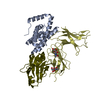
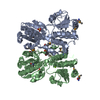
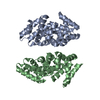
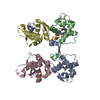

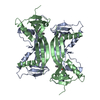
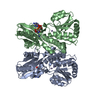
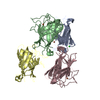
 PDBj
PDBj

